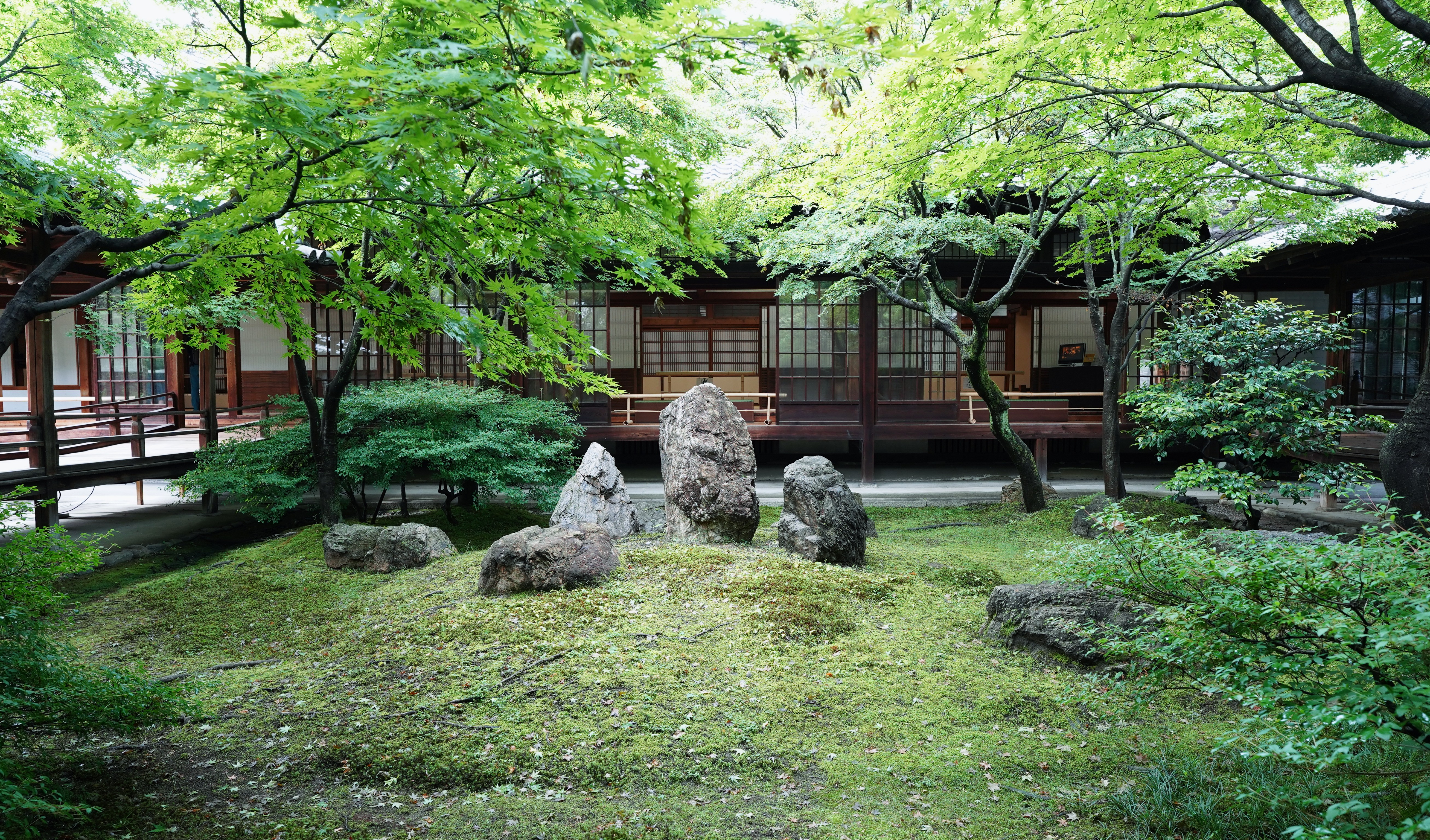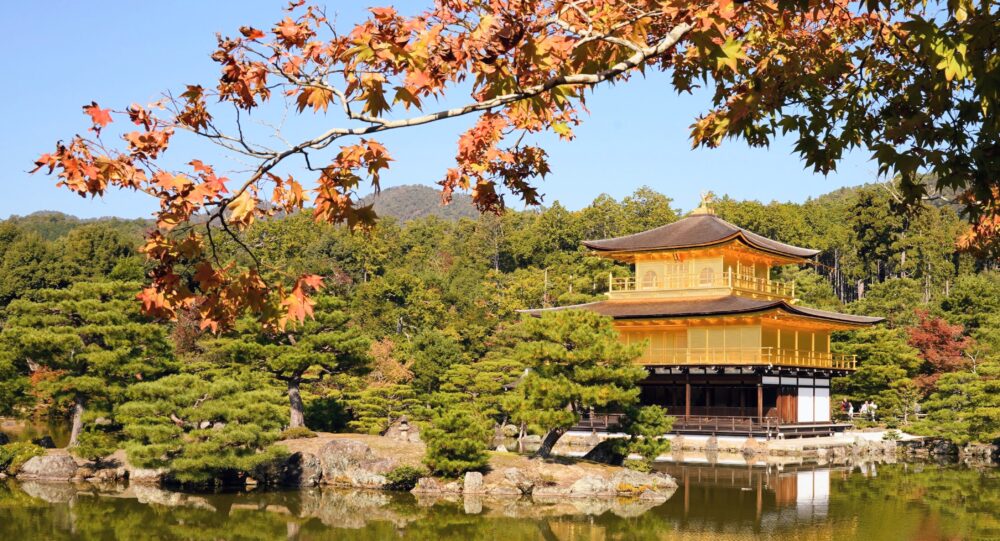Kyoto’s Autumn Illumination | 12 Best Spots and how to avoid crowds in 2024

Kyoto’s autumn illuminations, which run from early November to late December, are truly breathtaking. When the fall season arrives, this city known for its rich history and cultural heritage is transformed into a magical wonderland.
Here’s a look at the 12 best places to see Kyoto’s fall illuminations and how to avoid the crowds.
Kiyomizu-dera Temple
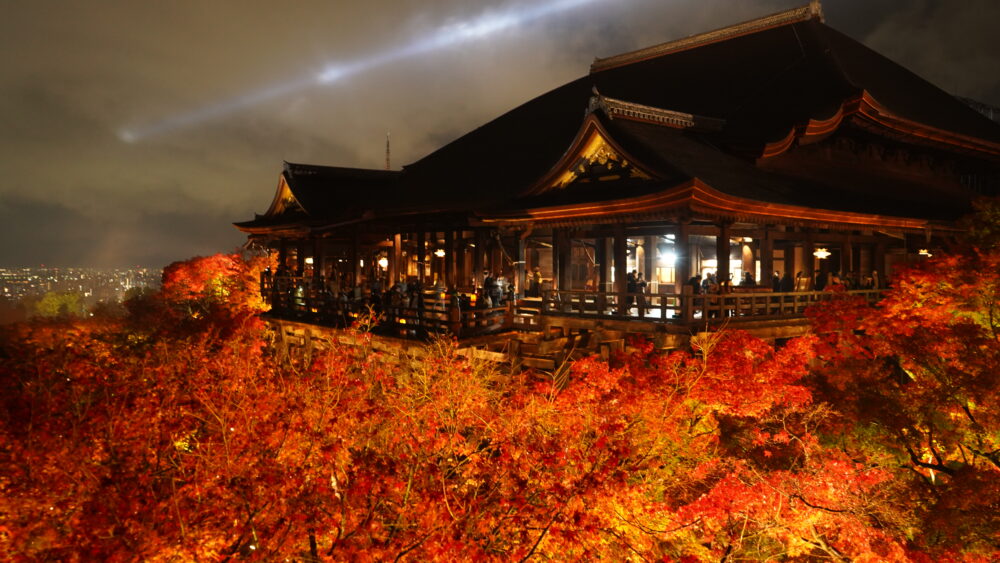
Kiyomizu-dera, located in eastern part of Kyoto City, stands as a testament to Japan’s rich historical and architectural heritage. One of the temple’s most captivating features is its maple trees, which during autumn, transform into a mesmerizing canvas of reds, oranges, and yellows.
The highlight is particularly the illumination evenings, where the sight of the wooden temple set against a backdrop of brilliantly illuminated maple leaves is nothing short of breathtaking. This experience, where the maple leaves are lit up against the night sky, offers a unique and enchanting ambiance that is distinct from daytime visits. However, visitors should be prepared for large crowds.
Jojuin temple
Jojuin temple, a sub-temple located on the west side of Kiyomizu-dera, is usually closed to the public but is specially opened and illuminated at night during spring and autumn each year. Visitors can view the pond garden from the tatami-floored main hall. The combination of autumn maple leaves, rock arrangements, and azaleas is beautiful. Since photography is prohibited, there are fewer people, and the garden maintains a quiet and peaceful atmosphere.
Tips to avoid crowds
- Weekends and public holidays tend to be the busiest. If possible, plan your visit on a weekday.
- The temple’s special evening event is scheduled from 6:30 p.m. to 9:30 p.m., with admission concluding at 9:00 p.m. It is advisable to visit soon after the event commences, as this time is typically less congested than the period just prior to closing.
- The bus to Kiyomizu-dera often gets packed, so consider walking from the station instead.
- Although there are three main routes to Kiyomizu-dera — Ninen-zaka street, Sannen-zaka street, and Gojo Street — all tend to get crowded.
- Kyoto provides a congestion forecast website that allows you to obtain advance information on crowd levels around Kiyomizu-dera temple area.
Congestion Forecast Service Website
Information
①Kiyomizu-dera temple
Open hours
| Period | Time |
|---|---|
| Normal | 6:00 a.m. – 6:00 p.m. |
| Special night viewing time (Nov.18- Nov.30) | 6:00 a.m. – 5:30 p.m. (Day time) 6:30 p.m. – 9:30 p.m. (Night time) (9:00 p.m. Last entry) |
※Temple is closed during after day time and before night time(5:30 p.m. – 6:30 p.m.)
Entrance fee
| Day time ticket ※Cannot be used as a Special night viewing ticket | Adults: 400 yen Children: 200 yen |
| Special night viewing ticket | Adults: 400 yen Children : 200 yen |
※Children are under 15 years of age.
②Jojuin temple
Open hours
| Period | Time |
|---|---|
| Autumn season Nov18 to Nov30 | 9:00 a.m. – 4:00 p.m. 6:00 p.m. – 8:30 p.m.(Special night viewing) |
Entrance fee
| Ticket type | Price |
|---|---|
| Day time ticket ※Cannot be used as a Special night viewing ticket | ・Adult: 600yen ・Elementary and junior high school student: 300yen |
| Special night viewingticket | ・Adult: 600yen ・Elementary and junior high school student: 300yen |
Address
1 Chome-294 Kiyomizu, Higashiyama Ward, Kyoto, 605-0862
How to get there
- 23-minute walking from “Kiyomizu-Gojo” station on Keihan Line
- 30-minute walk from Kyoto Kawaramachi Station on Hankyu Line
Official site
Kiyomizu-dera temple(English Text)

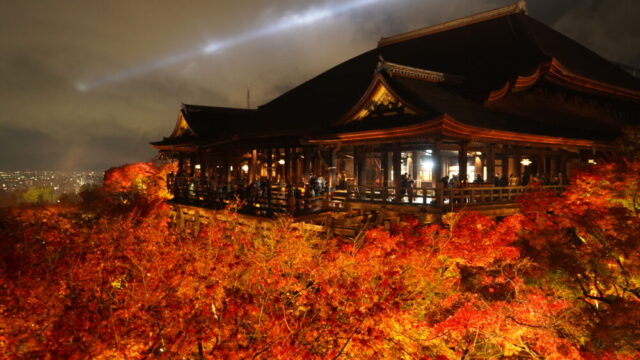
Kodaiji Temple
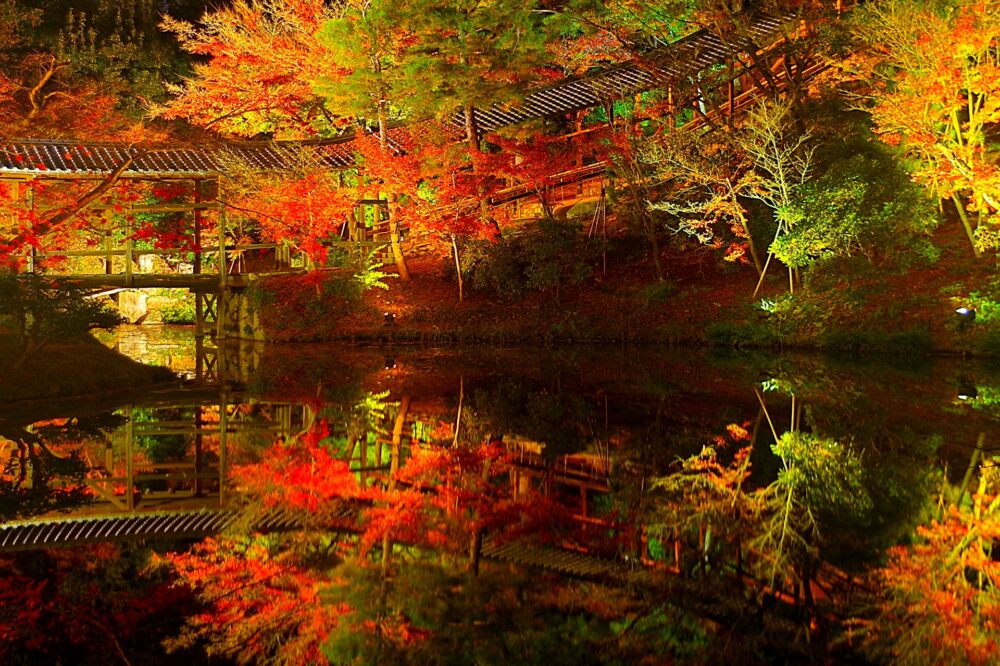
Kodaiji Temple is a Zen temple built in 1606 by Nene, also known as Kita-no-Mandokoro, the principal wife of Toyotomi Hideyoshi.
In the center of the temple grounds stands the “Kaizando”, a Buddhist hall constructed in 1605. Surrounding the Kaizando are two gardens, the eastern “Garyo-chi” and the western “Engetsu-chi”, together forming a pond-strolling garden. Around the pond, maple trees are planted, which turn beautifully red in autumn. The nighttime illumination of the garden is a breathtaking sight. The photo above shows the glossy maple leaves reflected in the pond and the corridor leading from the Kaizando to the spirit house, symbolizing a dragon.
Tips to avoid crowds
- Visit on weekdays, avoiding holidays and weekends.
- entering the temple grounds after 8:00 p.m. can help avoid the crowds.
- Since buses can get crowded, it’s better to walk from the nearest stations, Kiyomizu-Gojo Station or Kyoto Kawaramachi Station.
- Since Kodaiji Temple is just a 13-minute walk from Kiyomizu Temple, it’s a good idea to visit Kodaiji after viewing the light-up at Kiyomizu Temple.
Information
Open hours
| Period | Time |
|---|---|
| Normal | 9:00 a.m. – 5:30 p.m. (the entrance closes at 5:00 p.m.) |
| Special night viewing time (October.25th- December.15th ) | 5:00 p.m. – 10:00 p.m. (the entrance closes at 9:30 p.m. ) ※Visitors who enter by 5:00 p.m. can enjoy the light-up time without having to leave the garden. |
Entrance fee
| Ticket type | Price |
|---|---|
| Day time ticket or Special night viewing ticket | Adult: 600 yen High school and joiner high school student: 250 yen |
Adress
〒605-0825 Kyoto, Higashiyama, ward, Shimokawaramachi 526,Kodaiji
How to get there
- 18-minute walking from Kawaramachi Station on Hankyu Line
- 21-minute walking from Kiyomizu Gojo Station on Keihan Line
Official cite
Kodaiji(English text)
Entoku-in temple

Entoku-in Temple is a sub-temple of Kodai-ji Temple, located in Higashiyama Ward, Kyoto. Adjacent to Kodai-ji Temple, Entoku-in Temple was built in 1605 by Nene, the wife of Toyotomi Hideyoshi. She moved the ornate palace of Fushimi Castle and its front garden to the present site of Entoku-in Temple.
The north garden, which was based on the garden of Fushimi Castle, was later completed by the famous garden designer Kobori Enshu. This Karesansui (Japanese dry) garden features crushed granite, moss, stone arrangements, maple trees, and evergreen shrubs. Particularly unique are the large stone arrangements, said to have been contributed by various daimyo, symbolizing the immense power of Toyotomi Hideyoshi, who unified the country.
In the fall, the maple leaves turn a beautiful red, transforming the garden into a breathtaking sight. Nighttime illuminations create a magical atmosphere.
Tips to avoid crowds
Entoku-in tends to be less crowded than Kodai-ji, but it’s still a popular destination, especially during the peak fall foliage season. To ensure a more enjoyable visit, I recommend planning ahead. A combined ticket for both temples is available, which is a convenient way to explore both beautiful gardens.
- Visit on weekdays, avoiding holidays and weekends.
- Arriving at the temple at 8:00 a.m. will allow you to enjoy a more peaceful visit.
Information
・Night illumination
| Period | Time |
|---|---|
| October.25th to December.15th Close in December.12th and 13th | Entoku-in temple, Kodai-ji sho muse 5:00p.m. – 9:30 p.m. Kodai-ji temple 5:00 p.m. – 10:00 p.m. (Last entry is at 9:30 p.m. ) |
| Ticket Type | Price |
|---|---|
| Entoku-in temple | Adults : 500 yen Junior and high school students: 300yen |
| Combined Ticket (Entoku-in Temple, Kodai-ji temple, Kodai-ji sho museum) | Adults : 900yen |
・Day time
| Places | Time |
|---|---|
| Entoku-in Temple | 10:00 a.m. – 5:30 p.m. Last entry is at 5:00 p.m. |
| Kodai-ji sho museum | 9:00 a.m. – 5:00 p.m. Close in December 31st. |
| Ticket Type | Price |
|---|---|
| Entoku-in Temple Ticket | Adults : 500 yen Junior and high school students: 300yen |
| Combined Ticket (Entoku-in Temple, Kodai-ji temple, Kodai-ji sho museum) | Adults : 900yen |
The Kodai-ji sho Museum displays masterpieces treasured by Kodai-ji Temple and its affiliated temples.
Adress
〒605-0825 Kyoto, Higashiyama Ward, Takadai, Terashita Kawaramachi 530
How to get there
- 18-minute walking from Kawaramachi Station on Hankyu Line
- 21-minute walking from Kiyomizu Gojo Station on Keihan Line
Official site
Entoku-ji temple (English text)
Kodaiーji sho museum(Only Japanese text)
Kennin-ji Temple
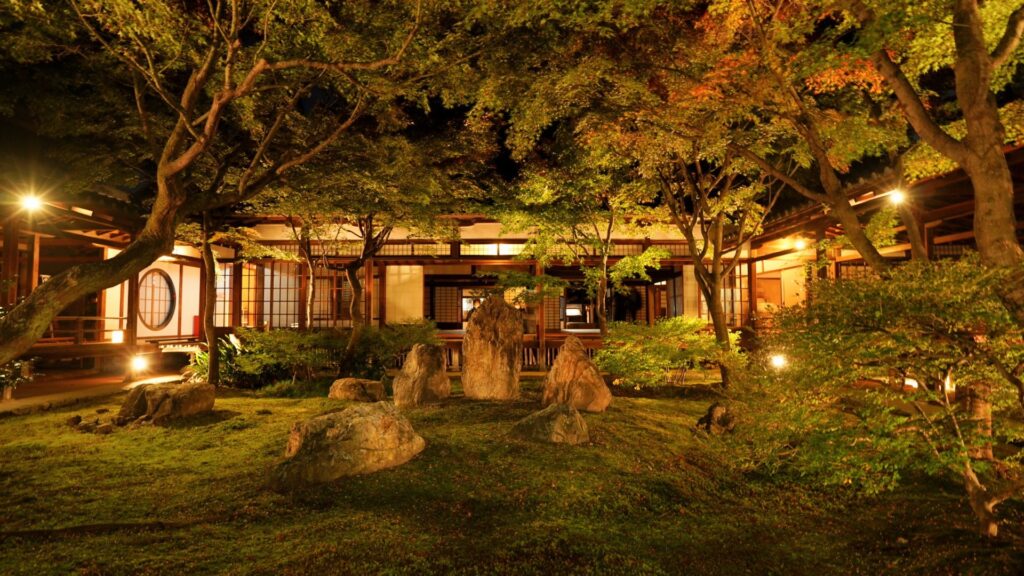
Kennin-ji, located in Gion-machi, east of Kyoto, is the head temple of the Rinzai sect of Zen Buddhism. Founded in 1202 by Eisai, who studied Zen in China, it is the oldest Zen temple in Kyoto. The main gate, Chokushi-mon Gate, and Sanmon Gate, Hatto Hall, and Hojo Hall are aligned in a straight line. The temple is famous for its twin dragon painting in Hodo Hall, its large dry landscape garden, Daio-en, and its inner garden, Choon-tei.
In the fall, the maple trees in the inner garden, Choon-tei, and on the temple grounds are beautifully colored. Kennin-ji offers night illumination by reservation only. The illuminated maple leaves create a magical atmosphere, and you’ll lose track of time as you admire their beauty. The vast Daio-en garden, illuminated by the lights, is also enchanting.
Tips to avoid crowds
Since Kennin-ji’s nighttime illuminations are by reservation only and have a limited capacity, you can enjoy a less crowded experience.
Given the large crowds in Kyoto during the peak fall foliage season (November and December), it’s advisable to use public transportation and arrive at Kennin-ji on time.
To reach the temple, take the Nara Line( Brown Line) from JR Kyoto Station to Tofukuji Station, then transfer to the Keihan Main Line(vermilion Line ) and get off at Gion-shijo Station. It’s about a 7-minute walk from there.
Another option is to take the Kyoto subway(Green Line ) from Kyoto Station to Shijo Station, transfer to the Hankyu Kyoto Line(Dark Brown Line) for Karasuma Station, and then get off at Kawaramachi Station. Kennin-ji Temple is a 9-minute walk from there.
Information
Nighttime Illumination
Open Hours
| Period | time |
|---|---|
| December.1st to 14th | 5:30 p.m. – 7:30 p.m. (Last entry is at 7:00 p.m.) |
Entrance Fee
Elementary school age and older : 1,800yen
Advance reservations are required for the autumn night illumination at Kennin-ji Temple.
Nighttime illumination ticket website.
Day time
Open Hours
10:00a.m. – 5:00p.m.
*The reception close at 4:30p.m.
Entrance fee
| Ticket types | Price |
|---|---|
| Adults | 800 yen |
| Students from high school to elementary school | 500 yen |
| Children under the age of elementary school | Free |
Adress
〒605-0811 Kyoto, Higashiyama Ward, Komatsucho, 584
Link
Official Website
https://www.kenninji.jp(Japanese Text Only)
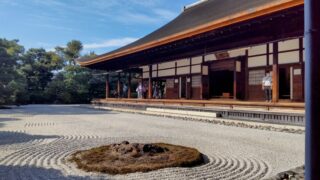

Tofuku-ji Temple

Tofuku-ji Temple, located in the eastern part of Kyoto, is the main temple of the Rinzai sect of Zen Buddhism. Founded by Enin in 1243 and completed in 1255, the temple was named Tofuku-ji, taking the characters “To” (east) and “Fuku” (blessing) from Todai-ji and Kofuku-ji temples in Nara. Despite suffering major fires in 1334, 1336, and 1881, Tofuku-ji was rebuilt each time. The temple grounds now contain numerous historic buildings, including the main entrance, main hall, Hojo hall, and Zen hall, all of which have been designated as important cultural properties.
There are over 2,000 maple trees on the temple grounds, including Japanese maples and mountain maples. In the fall, the maple leaves turn bright red, creating a breathtaking, dreamlike landscape, especially when viewed from the Tsutenkyo Bridge. Visitors can also enjoy the fall foliage by strolling through the valley on the temple grounds.
During the fall season, Tofuku-ji offers nighttime illuminations, allowing visitors to walk through the maple-lined valley and across the Tsutenkyo Bridge. With advance online reservations and limited capacity, visitors can enjoy a peaceful and magical experience while admiring the illuminated maple leaves.
Tips to avoid crowds
The nighttime illuminations at Tofuku-ji Temple require advance reservations and have limited capacity, so it won’t be crowded. However, since Kyoto is crowded with tourists during the fall foliage season, it’s best to take the train and walk to Tofuku-ji.
Take the Nara Line from JR Kyoto Station to Tofukuji Station. It’s about a 7-minute walk from the station to the temple.
Information
Nighttime Illumination
Open Hours
| Period | time |
|---|---|
| November.16th to December.1st | 6:30 p.m. – 7:30 p.m. (Last entry is at 7:00 p.m.) |
Admission Fee
Elementary school age and older : 2,800yen
Advance reservations are required for the autumn night illumination at Tofuku-ji Temple.
Nighttime illumination ticket website
Day time
Open hours
| Period | Time |
|---|---|
| April.1st to November.9th | 9:00a.m. -4:30p.m.(Last entry is at 4:00p.m.) |
| November.10th to 30th | 8:30a.m. – 4:30p.m.(Last entry is at 4:00p.m.) |
| December.1st to March.31st | 9:00a.m. – 4:00p.m.(Last entry is at 3:30p.m.) |
Regular holiday
None
Admission
Normal
| Place | Normal season |
|---|---|
| Honbo Garden (Hojo Garden) | Adults : 500 yen Elementary and junior high school students: 300 yen |
| Tuten-kyo & Kaizan-do area | Adults : 600 yen Elementary and junior high school students: 300 yen |
| Combined admission ticket (・Honbo Garden(Hojo Garden) ・Tuten-kyo & Kaizan-do area) | Adults : 1000 yen Elementary and junior high school students: 500 yen |
Special fall viewing
(November 10th to 30th)
| Places | Price |
|---|---|
| Tuten-kyo, Kaizando area | Adults: 1,000 yen Elementary and junior high school students: 300 yen |
| Tofuku-ji Honbo Garden | Adults: 500 yen Elementary and junior high school students: 300 yen |
Address
15 Chome-778 Honmachi, Higashiyama Ward, Kyoto, Tofukuji
Links and Resources
Tofuku-ji Temple(Japanese Text only)
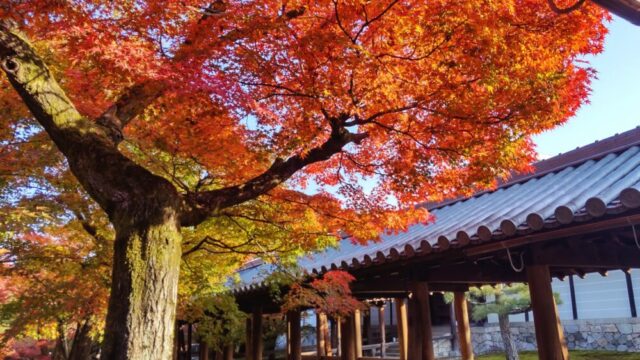
Toji temple

Toji Temple, nestled in the heart of Kyoto and recognized as one of the World Heritage Sites, is a treasure trove of historical buildings, including
- Five-storied Pagoda:
special opening of the first tier of the National Treasure - Kodo:
an entrance into the world of three-dimensional mandalas - Homotu-kan:
historical museum protects and conveys the temple’s treasures, as Commemorating the 1200th anniversary of the founding of the Shingon sect. - Kanchi-in:
a sub-temple that became the center of Esoteric Buddhist teachings and a National Treasure.
The various types of maple trees within Toji’s gardens contribute to the autumnal tapestry with leaves that turn into vibrant shades of red, orange, and yellow. Moreover, light-up event casts a celestial aura over the entire temple complex, creating a magical atmosphere that draws visitors from all over the world.
As you wander through the temple grounds, the illuminated five-story pagoda is reflected in the strolling pond garden”Hyotan-ike” (a pond shaped like a gourd) , a captivating vision amidst the vivid colors of the maple trees. This interplay of light and nature is truly a spectacle to behold.
Tips to avoid crowds
- Visit around 8:30 p.m., an hour before closing, when it’s less crowded. This allows you to experience the tranquility of the temple and its gardens without the bustle of peak visitor hours.
- Opt for a weekday night. Weekends tend to attract larger crowds, so a visit on a weekday can offer a more serene experience.
- Toji Temple offers early admission tickets that can be purchased online in advance. While the night illumination begins at 6:00 p.m., early admission ticket holders have the privilege of entering the temple at 5:10 p.m. This exclusive access allows you to explore the temple grounds and enjoy the stunning illuminations before the crowds. I highly recommend purchasing these tickets in advance to ensure a smooth and enjoyable visit.
Early Admission Ticket Site - Kyoto City offers a real-time congestion forecast service that allows visitors to check the expected level of congestion around Toji temple, near by Kyoto station.
Congestion Forecast Service Website
Information
Open hours
・Special night viewing
| Place and Period | Time |
|---|---|
| Kondo and Kodo ( October.26th to December.8th) | 6:00 p.m. – 9:00 p.m. ( the entrance closes at 8:30 p.m.) |
※Temple is closed during after day time and before night time(5:00 p.m. – 6:00 p.m.)
| Place | Price |
|---|---|
| Kondo and Kodo | ・Adult: 1,000 yen ・Junior high school students and younger : 500 yen |
・Day time
| Place and Period | Time |
|---|---|
| ・Kondo ・Five-storied pagoda first floor ・Kodo (October.26th to November.25th) | 8:00 a.m. – 5:00 p.m.( the entrance closes at 4:30 p.m.) |
| Kanchi-in and Homotu-in (September. 20th to November.25th) | 9:00 a.m. – 5:00 p.m. ( the entrance closes at 4:30 p.m.) |
Entrance fee
・Day time ticket
※Cannot be used as a Special night viewing ticket
| Place | Price |
|---|---|
| Five-storied pagoda first floor, Kondo and Kodo | ・Adults: 800yen ・High school students : 700yen ・Junior high school students and younger: 500yen |
| Kanchi-in | ・Adult: 500 yen ・Junior high school students and younger: 300yen |
| Homotu-kan | ・Adult: 500 yen ・Junior high school students and younger: 300yen |
| All Places | ・Adult: 1,300 yen ・Junior high school students and younger: 800 yen |
Adress
1 Kujocho, Minami Ward, Kyoto, 601-8473
How to get there
- 14-minute walking from Kyoto Station to Toji Keigamon entrance gate(East)
- The nearest bus stop is “Toji Higashi-monmae,” and you can take city buses number 16 or 71 from the Hachijo-guchi (south exit) of Kyoto Station.
Official site
Toji temple (English Text)

Eikando

Eikando Temple, known formally as Zenrinji Temple, offers one of Kyoto’s most exquisite autumn experiences. During the autumn, the temple’s grounds come alive with a vibrant display of seasonal colors and lights, drawing visitors into a centuries-old landscape of beauty and tranquility.
The main garden features a pond strolling garden known as “Hojochi,” which signifies a pond specifically created to release captured fish and other aquatic life. Surrounding the pond, a multitude of trees, including maples with their fiery red leaves, crape myrtle, and golden ginkgoes , create a rich tapestry of autumnal shades.
A highlight of the illumination at Eikando is the “Tahoto”, a distinctive double-story pagoda characterized by its circular upper story and square lower story. During the illumination, this architectural marvel is gently lit, emphasizing its unique design and augmenting the mystical aura of the temple environs.
Tips to avoid crowds
- Choose Weekdays Over Weekends and Holidays
- Get to the temple shortly before the illumination begins at 5:30 pm to enjoy the temple grounds with fewer people.
- Walking and using the trains is better to get there in time than using buses.
Information
Open hours
| Period | Time |
|---|---|
| Normal | 9:00 a.m. – 5:00 p.m. (the entrance closes at 4:00 p.m.) |
| Special night viewing time November.11th to December.1st | 5:30 p.m. – 9:00 p.m. (the entrance closes at 8:30 p.m.) |
| Temple Treasure Exhibition November.11th to December.8th | 9:00 a.m. – 5:00 p.m. (the entrance closes at 4:00 p.m.) |
※Temple is closed during after day time and before night time(17:00 – 17:30)
Entrance fee
| Period | price |
|---|---|
| Normal | ・Adults(Age19 to over) : 600yen ・Children(Age 6 to 18): 400yen |
| Autumn exhibition (Nov 3rd – Dec 3rd) | ・Adults(Age19 to over) : 1,000yen ・Children(Age 6 to 18): 400yen |
| Special night viewing (Nov 3rd – Dec 3rd) | Adults(Age13 to over): 700yen |
How to get there
- 12-minutes walking from Keage station on Tozai Line
- The nearest bus stop is “Nanzenji-eikando-mich,” and you can take city buses number 5 from Kyoto Station north gate.
Adress
48 Eikandocho, Sakyo Ward, Kyoto, 606-8445
Official site
Eikando night visit

Ruriko-in Temple

Rurikoin Temple is a Jodo Shinshu temple located in Sakyo-ku, northern Kyoto. Originally built as a villa named Kikakutei by Gen’taro Tanaka, a businessman, it was purchased by Komyoji Temple in 2005 and rebuilt as a branch temple, Rurikoin.
The temple is famous for its stunning view of autumn foliage reflected on the polished table in the shoin room on the second floor. The temple is also known for a beautiful Ruri Garden, where a carpet of moss shimmers with an emerald green hue. In addition, visitors can enjoy the unique experience of copying sutras using the kits provided upon entering the temple.
At night, the temple is completely illuminated by reservation only, creating a truly magical and breathtaking scene.
Tips to avoid crowds
Since night visits to Rurikoin Temple are by reservation only, you can expect a more peaceful experience. However, during the peak fall season, the roads leading to the temple can be congested. To avoid delays, it’s best to take public transportation such as trains and walk the rest of the way.
Information
Nighttime Illumination
Open Hours
| Period | Time |
|---|---|
| November.9th, 10th, 15th to December.1st | 6:15 p.m. – 8:00 p.m. (Last entry is at 7:00 p.m.) |
Price
People aged 7 and over : 7,000 yen
Ruriko-in Nighttime Illumination Ticket website(Only Japanese text)
the reservation site is displayed in Japanese only. Please use a translation tool when making your reservation.
Important Notice for Nighttime Illumination Ticket Holders
*Before visiting Rurikoin Temple, please exchange your ticket for a “Rurikoin Temple Nighttime Special Viewing Ticket” at Demachiyanagi Station on the Eizan Electric Railway. This exchange ticket includes a one-day pass for the Eizan Electric Railway, a round-trip ticket for the Eizan Cable, and a Kawara-kae exchange ticket. Please note that direct access to the temple is not allowed.
Day Time
Open hours
| Period | Time |
|---|---|
| October.1st to 8th, and December.2nd to 15th | 10:00 a.m. – 5:00 p.m.(Last entry is at 4:30 p.m.) |
| Special Fall Season November.9th to December.1st | 9:00 a.m. – 6:00 p.m.(Last entry is at 5:40 p.m.) * Need the reservation |
Entrance Fee
Adults : 2,000yen
Joiner and High school students : 1,000 yen
Reservation
Ruriko-in Temple will operate a reservation system during the fall foliage season from November 9th to December 1th.
Please use the following link to reserve your tickets.
Ruriko-in Temple Ticket Website(Japanese text Only)
The reservation site is displayed in Japanese only. Please use a translation tool when making your reservation.
How to get there
A 10-minute walk from Eizan Electric Railway Yase-Hieizan-guchi Station
Adress
Ruriko-in Temple :
55 Kamitakano Higashiyama, Sakyo Ward, Kyoto, 606-0067
Demachiyanagi Station on Eizan Electric Railway :
32-1 Tanaka Kamiyanagicho, Sakyo Ward, Kyoto, 606-8205
Link
Ruriko-in Temple Official Website(English Text)
Nijo-jo Castle

Nijo-jo Castle was built in 1603 by Tokugawa Ieyasu, the first shogun of the Edo shogunate, as a residence and protective fortress for the Imperial Palace in Kyoto, as well as a lodging place for the shogun during his visits to Kyoto. Within the castle grounds, you can see the “Ninomaru-goten palace” a representative example of a samurai-style shoin-zukuri (study-style) building from the Edo period.
There is also the “Ninomaru Garden,” a strolling-style garden around a pond, which is a quintessential example of Japanese pond gardens. It was originally landscaped by Kobori Enshu in the early Edo period and later remodeled under the orders of the third shogun, Tokugawa Iemitsu. Additionally, the castle features a Tang-style gate and other elements that showcase the architectural style of the Momoyama period. Due to its historical significance, Nijo-jo castle was registered as a UNESCO World Heritage Site in 1994.
It’s also famous for its night illumination. Nijō Castle, a historic building, is illuminated, especially the projection mapping on the Kara-mon gate and the castle walls with its autumn scenes is breathtaking. Inside, there’s also a market with a “Kyoto Specialty Products Exhibition” where you can find various local products.
Tips to avoid crowds
- Visit on a weekday instead of a holiday.
- The event is very crowded with tourists, especially during the illumination. You may have to wait in line for more than 30 minutes to purchase tickets at the front desk. I highly recommend purchasing tickets in advance for a smoother entrance.
Website for Purchasing Illumination Tickets - Arrive at the ticket reservation line (separate from the same-day ticket purchase line) 30 minutes before the castle opens at 5:30 pm. Alternatively, arriving 1.5 hours before closing may help you avoid crowds.
Information
・Night illumination
| Period | Time |
|---|---|
| October.25th to December.8th | 6:00 p.m. – 10:00 p.m. (the entrance closes at 9:00 p.m.) |
| Days of week | Price |
|---|---|
| Monday to Thursday | Adults up to middle school students: 2,000 yen Junior high school students : 1,200 yen |
| Friday to Sunday and holiday | Adults up to middle school students: 2,400 yen Junior high school students : 1,600 yen |
I recommend to purchase tickets in advance to avoid crowded.
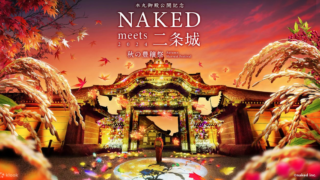
・Day time
| Place | Time |
|---|---|
| Nijo-jo castle | 8:45 a.m. – 5:00 p.m. (the entrance closes at 4:00 p.m.) |
| Ninomaru-goten Palace | 8:45 a.m. – 4:10 p.m. |
| Honmaru-goten Palace | 9:30 a.m. – 4:00 p.m. |
Closed days
・Nijo-jo castle
December 29 to 31
・Ninomaru-goten Palace
Every Tuesday in January, July, August, and December, January 1 to 3, and December 26 to 28
※When any of the above-mentioned days fall on a public holiday, Ninomaru-goten Palace will be closed the following day instead.
Entrance fee
| Place | Price |
|---|---|
| Nijo-jo castle | Adult : 800yen Junior high school : 400yen Elementary school : 300yen |
| Nijo-jo Castle and Ninomaru-goten Palace | Adult : 1300yen Junior high school : 400yen Elementary school : 300yen |
※Entrance fee is free for children younger than elementary school age.
Adress
541 Nijojocho, Nakagyo Ward, Kyoto, 604-8301
How to get there
To get to Nijo Castle from Kyoto Station by train, take a subway on the Karasuma Line and get off at Karasuma Oike Station. Then transfer to the Tozai Line for Uzumasa Tenjin and get off at Nijojo-mae Station. The east entrance of Nijo Castle is a 6-minute walk from the station.
Links and Resources
Official website
Nijo-jo castle(English Text)

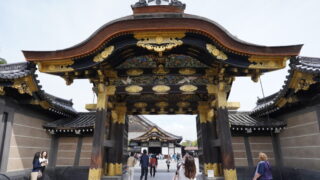
Hogon-in Temple

Hogon-in Temple is a sub-temple of Tenryu-ji Temple, a major Zen temple, located in Arashiyama, Kyoto. Founded in 1461 by Shochu Eiko, grandson of the first abbot of Tenryu-ji Temple, Hogon-in was originally located in the northern part of Kyoto, but was moved to its present location in Arashiyama. The temple’s impressive garden features a massive rock formation resembling a lion’s face, known as “Shishi-iwa,” and a dry landscape garden composed of crushed granite and arranged rocks.
In the fall, the maple trees in the garden turn bright shades of red, creating a magical scene. At night, the temple is illuminated, drawing large crowds to witness the fiery maple leaves.
Tips to avoid crowds
To fully enjoy your visit to the Hōgon-in Temple, located in the popular Arashiyama district of Kyoto, it’s best to plan your trip in advance.
- Weekdays: Weekdays are recommended to avoid crowds, as locals often visit Arashiyama on weekends.
- Around 7:30 p.m.: Arriving around 7:30 p.m., one hour before closing time, is a good option to avoid crowds and enjoy the quiet atmosphere of the evening garden.
Information
Open Hour
| Period | Time |
|---|---|
| Day time October.5th to December.8th | 9:00 a.m. – 5:00 p.m. (Last entry is 4:45 p.m.) |
| Night time November.15th to December.8th | 5:30 p.m. – 8:30 p.m. (Last entry is 8:00 p.m.) |
Entrance Fee
| Ticket Type | Price |
|---|---|
| Day time ticket | Adults : 700 yen Junior and middle school students : 300 yen |
| Day time and Special public viewing of Hogon-in main hall | Adults : 1,200 yen Junior and middle school students : 600 yen |
| Discount combination ticket for Visiting Hogon-in and Kōgen-ji Temples | Adults : 1,000yen |
| Night time ticket | Adults : 1,000 yen Junior and middle school students : 300 yen |
Adress
〒616-8385 Kyoto, Ukyo Ward, Sagatenryuji Susukinobabacho, 36
How to get there:
Train and walking: Kyoto can be crowded, especially in the fall. To avoid the traffic, it’s best to travel by train and walk.
Travel time:
- 9-minute walk from Arashiyama Station on the Randen Line
- 15 minutes walk from Saga-Arashiyama Station on the JR Line
- 16 minutes walk from Arashiyama Station on the Hankyu Line
Link and Resources
Official website
Hogoin-temple(English text)
Kifune Shrine

Kifune Shrine is located in Kurama-Kifunecho, northern Kyoto, and is the head shrine of approximately 500 Kifune sub-shrines nationwide. The shrine is divided into three parts: Hongu (main shrine), Yuiyashiro (sub-shrine), and Okunomiya (inner shrine), which are located along the Kifune River. Although the exact year of its founding is unknown, records indicate that a shrine building existed as early as 677. In the main shrine, Takao Kaminokami is worshipped as the deity who protects Kyoto’s water source.
A highlight of Kifune Shrine is the vermilion Torii gates that line the steps leading to the entrance. In the fall, these gates, along with the surrounding maple trees, create a magical landscape.
During the fall season, nighttime illuminations are held to light up the shrine grounds and nearby inns. In addition, the Momiji tunnel of the Eizan Electric Railway leading to the Kifune Shrine is also illuminated.
Tips to avoid crowds
Kifune Shrine is located far from the center of Kyoto, so it is not crowded. However, during the fall season (from November to early December), the road leading to Kifune Shrine becomes congested, so it is recommended to travel by train and on foot.
From November 9th to November 24th, the Eizan Electric Railway will conduct a night illumination, so using this railway will allow you to see beautiful scenery. Buses from Kifuneguchi Station, the closest station to Kifune Shrine, are not crowded, so this is the only bus route available.
Bus timetable: Bus stop from Kifuneguchi Station to Kifune Shrine(November 9th to 24th)
https://www.kyotobus.jp/rosen/~pdf/20241109_kibune.pdf
Information
Kifune Shrine
Nighttime Illumination
| Period | Time |
|---|---|
| November.9th to 24th | Sunset to 8:30 p.m. |
Entrance Fee : Free
Day time
Open hours
| Period | Time |
|---|---|
| May 1st to November 30th | 6:00a.m. to 8:00p.m. (Reception open from 9:00a.m. to 5:00p.m.) |
| December 1st to April 30th | 6:00a.m. to 6:00p.m. (Reception open from 9:00a.m. to 5:00p.m.) |
Entrance Fee : Free
Eizan Electric Railway
Kifuneguchi, the nearest station to Kifune Shrine, is served by the Eizan Electric Railway. The railway conducts a light event in the “Maple Tunnel” between Ichihara Station and Ninose Station on the Kurama Line, which is on the way to Kifuneguchi.
Trains passing through the “Maple Tunnel” have their lights turned off and slow down, allowing passengers to enjoy the fantastically illuminated fall foliage.
Adress
Main shrine
180 Kuramakibunecho, Sakyo Ward, Kyoto, 601-1112
How to get there
Take the JR Nara Line (Brown Line )from Kyoto Station to Tofukuji Station. Transfer to the Keihan Main Line(Orange Line) at Tofukuji Station and get off at Demachiyanagi Station. From Demachiyanagi Station, take the Eizan Electric Railway(Yellow Line)and get off at Kibuneguchi Station.
From the Eizan Kibuneguchi-mae bus stop, take a No. 33 Kyoto Bus to the Kibune bus stop. It is an 11-minute walk from the bus stop to Kibune Shrine.

Link
Official Website
Kifune shrine(English text)
Daigo-ji Temple
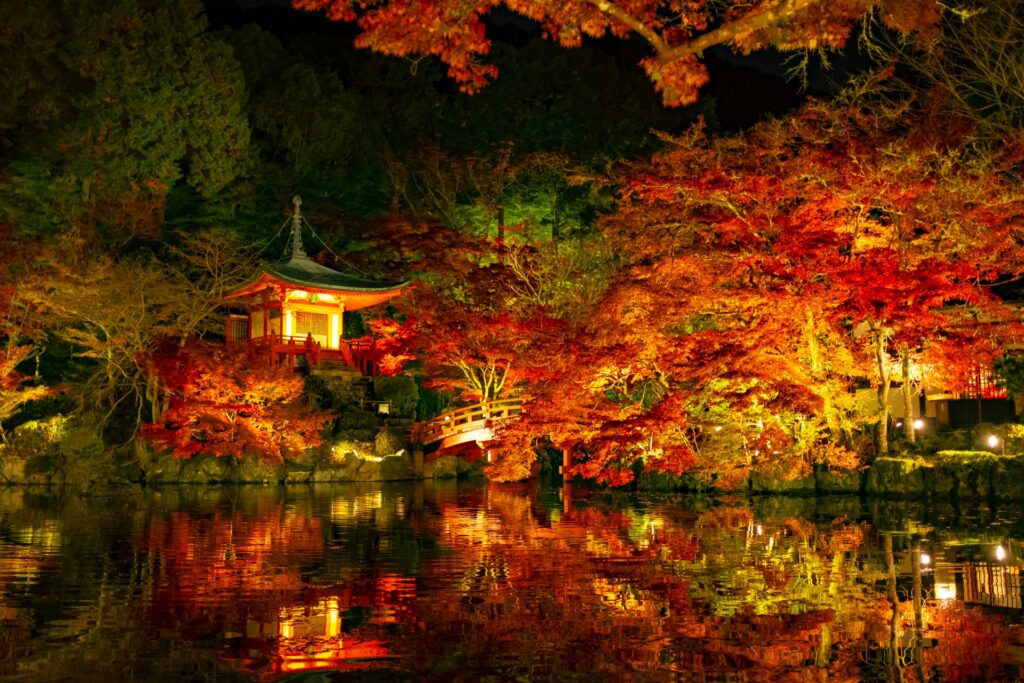
Daigo-ji Temple, the main temple of the Daigo sect of the Shingon school, is located in the eastern part of Kyoto, specifically in Fushimi Ward. Founded in 874 by Namu shozo Boshi, the temple’s origins can be traced back to the upper reaches of Mt. Kami-Daigo. The Yakushi-do Hall was built in 907, followed by the iconic five-story pagoda in 951, a highlight of the temple. Today, the entire Kami-Daigo Mountain serves as the temple’s sacred precinct, divided into two distinct areas: Shimo Daigo at the base of the mountain and Kami Daigo, an hour’s climb higher.
Daigo-ji has two exquisite gardens. The Sanboin Garden, centered around a tranquil pond, was built in 1598 and offers breathtaking views from the main hall. With quintessential Japanese garden elements such as Turtle Island and Crane Island, the garden exudes a tranquil atmosphere.
For those seeking fall splendor, Daigo-ji offers an enchanting array of maple and ginkgo trees, especially in the Muryoju-in Garden, located northeast of Shimo Daigo. The garden, which houses the Benzaiten Hall, is transformed into a vibrant tapestry of color during the fall foliage season. Nighttime illuminations enhance the beauty of the temple and cast a magical glow on the reflecting pond.
Tips to avoid crowds
Daigo-ji Temple is a popular place to view the fall foliage, especially during the peak season. Here are some tips to avoid the crowds:
- Visit after 7:30 p.m.: While the nighttime opening is popular, it can be crowded at first. Consider going a little later to avoid the initial rush.
- Visit on a weekday: Weekends are busy with both domestic and international tourists. Visiting on a weekday evening can offer a more peaceful experience.
- Go straight to the Muryoju-in Garden: If you want to enjoy the magical night illuminations without the crowds, go to Muryoju-in Garden, the farthest point in the temple, first. Then you can work your way back and see the other buildings at a more leisurely pace.
Information
Nighttime Illumination
| Period | Time |
|---|---|
| November.22th to December.1st | 6:00 p.m. – 8:50 p.m.(Last entry is at 8:10 p.m.) |
| Places | Price |
|---|---|
| Garan Area(Muryoju-in Garden, Five-story Pagoda, Kondo Hall) | Age over junior high school students : 1,000yen |
Day Time
| Period | Time |
|---|---|
| March.1st to December.1st | 9:00 a.m. to 5:00 p.m. |
| December2nd to February28th | 9:00 a.m. to 4:30 p.m. |
| Places | Price |
|---|---|
| Sanbo-in garden and Garan Area(Muryoju-in Garden, Five-story Pagoda, Kondo Hall) | Adults: 1,000yen junior high and high school students: 700yen |
| Sanbo-in garden or Garan Area(Muryoju-in Garden, Five-story Pagoda, Kondo Hall) | Age over junior high school students : 600yen |
| Sanbo-in Special Viewing (Sanbo-in garden, Main hall, Okushinden hall) | Age over junior high school students : 500yen |
| Reihokan Museum | Age over junior high school students : 500 yen |
Adress
22 Daigohigashiojicho, Fushimi Ward, Kyoto, 601-1325
How to Get there
It’s a 13-minute walk from Daigo station on the Tozai subway line.
Links and Resources
Official website
Daigoji tem(English text)



